Like a breath of fresh air in a stale office, indoor plants can transform your workspace from mundane to magnificent. You’ll discover how these seven carefully selected plants can boost your productivity, clean your air, and create a more inviting environment—all while requiring minimal maintenance. From hardy survivors that thrive on neglect to elegant flowering specimens, each plant offers unique benefits that’ll make your nine-to-five experience significantly more enjoyable. Let’s explore which green companion might be your perfect desk mate.
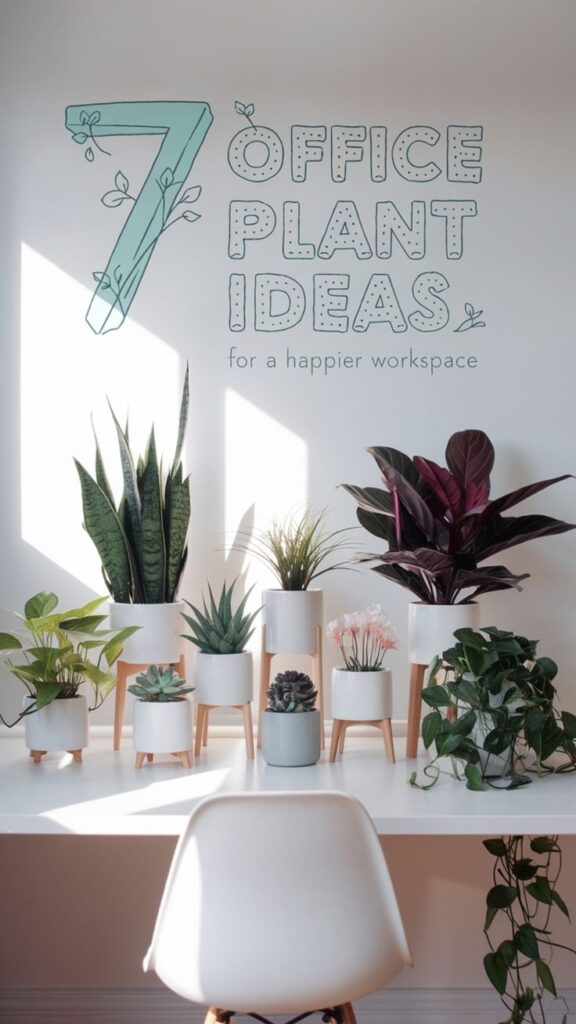
Contents
Snake Plant: The Indestructible Air Purifier
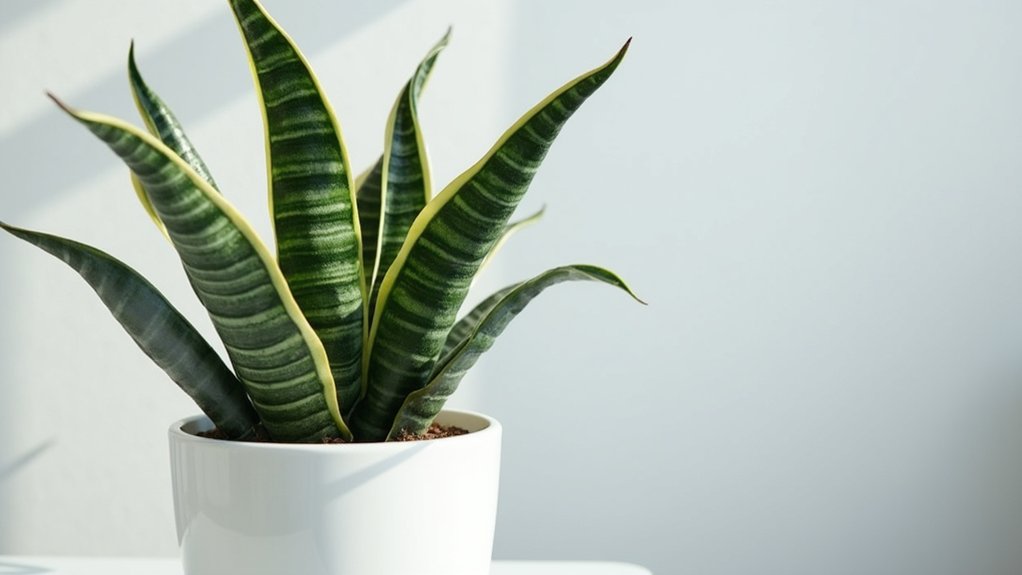
The Snake Plant (Sansevieria) is a striking succulent featuring tall, rigid leaves that grow upright in a sword-like formation. Its distinctive appearance includes dark green leaves with light green or yellow patterns, sometimes featuring snake-like markings that inspired its common name.
Known for being one of the most tolerant indoor plants, it excels at removing indoor air pollutants like formaldehyde and benzene, while producing oxygen even at night, making it an excellent choice for office spaces.
Growing Conditions:
- Light: Tolerates low to bright indirect light; avoid direct sunlight
- Water: Allow soil to dry completely between waterings; water less in winter
- Soil: Well-draining potting mix; preferably with sand or perlite added
- Temperature: Comfortable in average room temperatures (60-85°F)
- Humidity: Adapts to any humidity level; no special requirements
Regular maintenance for a Snake Plant is minimal but important for long-term health. Remove any yellow or brown leaves by cutting them off at the base, and dust the leaves periodically with a damp cloth to maintain their ability to photosynthesize effectively.
Watch for signs of overwatering, which is the most common problem, manifested as soft, mushy leaves or brown spots. Repot every 2-3 years when the plant becomes root-bound, and divide large clusters to propagate new plants if desired.
Pothos: A Low-Light Champion
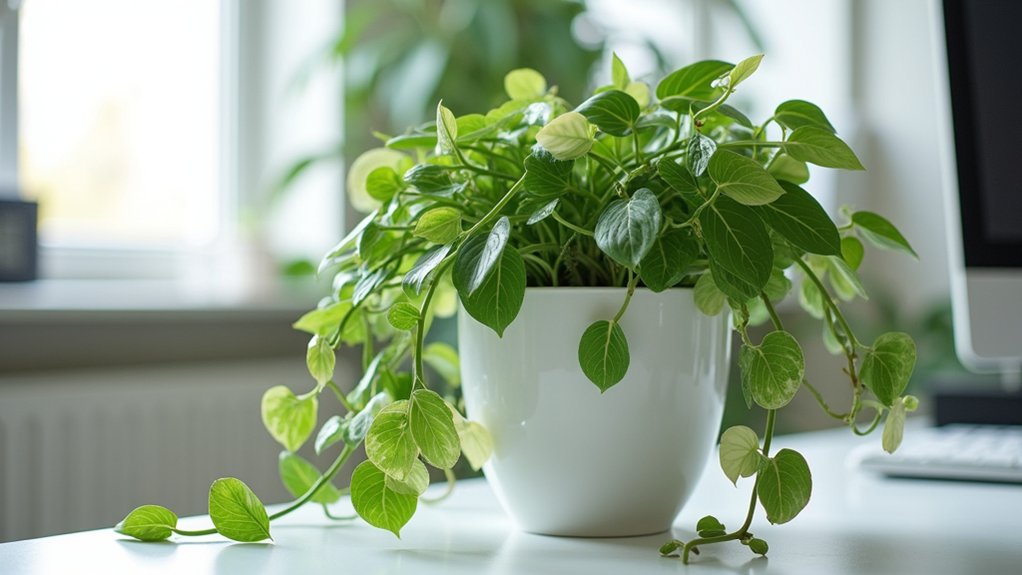
Growing Conditions:
- Light: Tolerates low to moderate light; avoid direct sunlight
- Water: Allow top 1-2 inches of soil to dry between waterings
- Soil: Well-draining potting mix
- Temperature: 60-80°F (15-27°C)
- Humidity: Adaptable to average indoor humidity levels
- Fertilizer: Monthly feeding with balanced liquid fertilizer during growing season
To maintain a healthy pothos, regularly trim leggy vines to promote bushier growth and remove any yellowed or damaged leaves promptly.
Dust the leaves monthly with a damp cloth to keep them glossy and maintain their photosynthetic efficiency.
While pothos can survive neglect, rotating the plant quarterly ensures even growth, and occasional misting can prevent leaf tip browning in dry office environments.
Checking for pests, particularly mealybugs and spider mites, should be part of routine maintenance.
Peace Lily: Elegant and Stress-Reducing
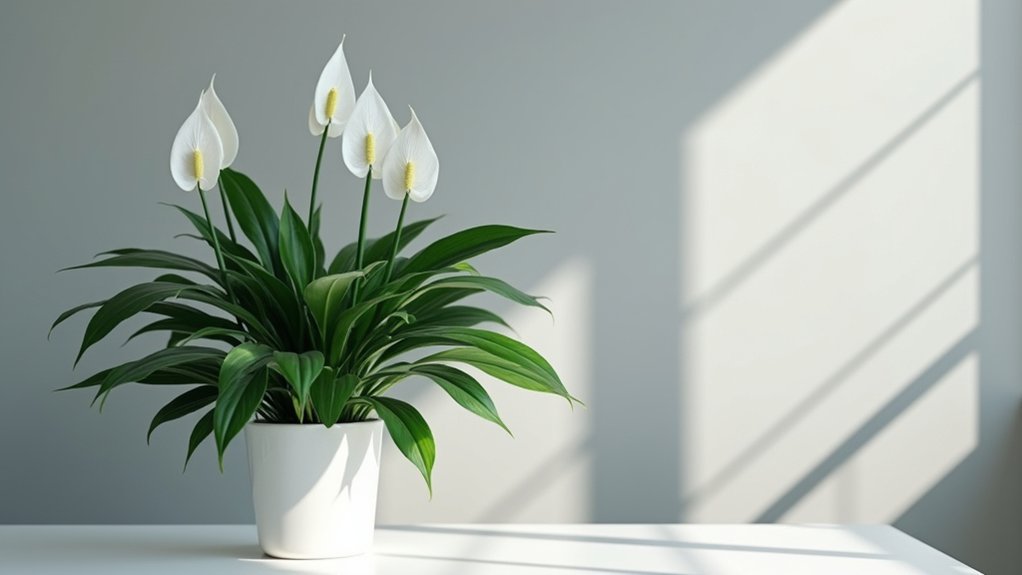
The Peace Lily (Spathiphyllum) is a striking indoor plant characterized by its glossy, dark green leaves and distinctive white flowers that bloom throughout the year.
This elegant plant features long, lance-shaped foliage that grows in clumps, creating a lush, tropical appearance. Beyond its aesthetic appeal, the Peace Lily is known for its air-purifying abilities, effectively removing common indoor pollutants while helping to reduce stress levels in office environments.
- Light: Thrives in medium to low indirect light; avoid direct sunlight
- Water: Keep soil consistently moist but not waterlogged; water when top inch of soil feels dry
- Soil: Well-draining potting mix rich in organic matter
- Temperature: Prefers 65-80°F (18-27°C)
- Humidity: Enjoys moderate to high humidity levels
- Fertilizer: Feed with balanced liquid fertilizer every 6-8 weeks during growing season
Regular grooming is essential for maintaining a healthy Peace Lily in the office setting.
Remove yellowed or damaged leaves at the base using clean, sharp scissors, and dust the leaves monthly with a damp cloth to maintain their glossy appearance and ensure efficient photosynthesis.
Watch for signs of overwatering, such as leaf yellowing or root rot, and adjust care accordingly.
When flowers fade, cut the stalks down to the base to encourage new blooms and maintain the plant’s attractive appearance.
ZZ Plant: Perfect for Plant Beginners
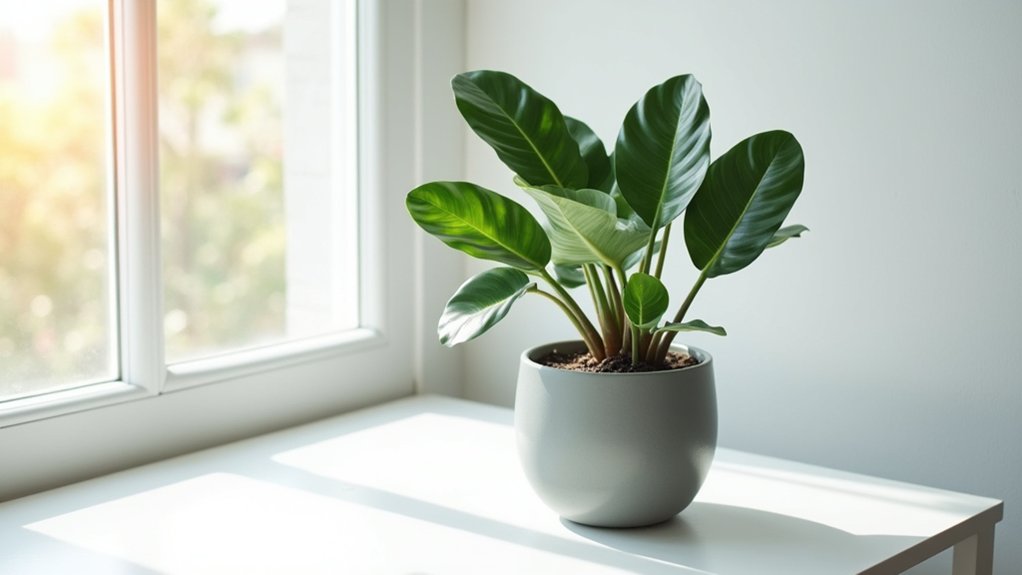
The ZZ Plant (Zamioculcas zamiifolia) is a striking, glossy-leafed plant that’s become increasingly popular in office settings due to its exceptional durability and low-maintenance nature.
Its dark green, oval-shaped leaves grow in a symmetric pattern along thick stems, creating an elegant, almost artificial appearance. The plant’s ability to thrive in neglectful conditions and its natural resistance to pests make it an ideal choice for plant beginners and busy professionals.
Growing Conditions:
- Light: Tolerates low to bright indirect light; avoid direct sunlight
- Water: Allow soil to dry completely between waterings; water every 2-3 weeks
- Soil: Well-draining potting mix with added perlite
- Temperature: 65-75°F (18-24°C)
- Humidity: Adapts to normal indoor humidity levels
- Container: Pot with drainage holes to prevent root rot
To maintain a healthy ZZ Plant, remove any yellowing leaves promptly and dust the leaves monthly with a damp cloth to maintain their glossy appearance and ensure optimal photosynthesis.
Rotate the plant quarterly to promote even growth, and inspect the rhizomes occasionally for signs of overcrowding, which indicates the need for repotting.
While the plant is naturally slow-growing, a balanced, water-soluble fertilizer applied once every six months during the growing season can support sustained health.
Spider Plant: Nature’s Air Filter
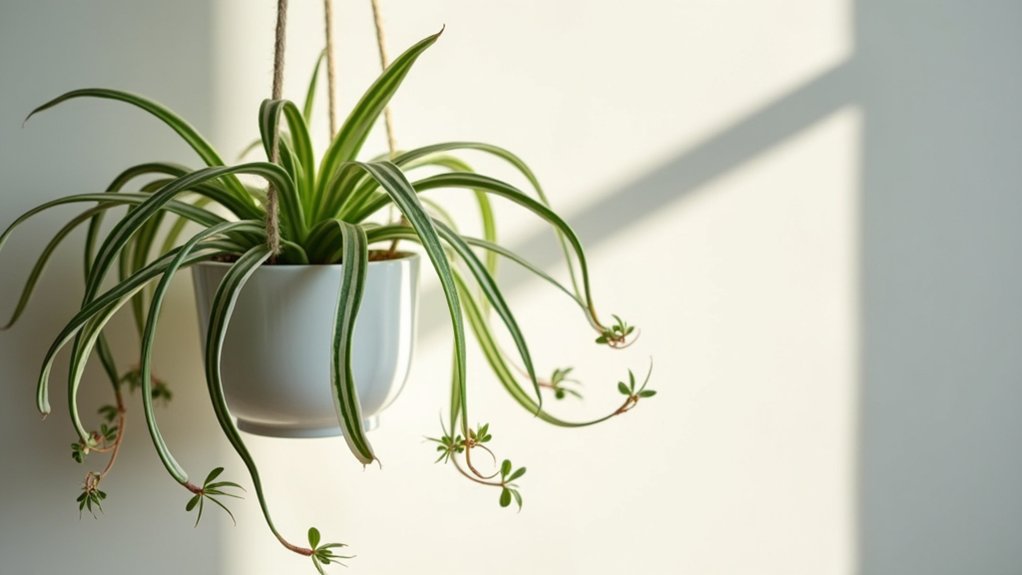
Spider plants (Chlorophytum comosum) are elegant, arching plants with long, slender leaves featuring distinctive white or cream stripes. Their cascading nature makes them perfect for hanging baskets or elevated shelves, as their offspring, known as “spiderettes,” dangle from long stems like tiny spiders on a web.
Beyond their aesthetic appeal, spider plants are renowned for their air-purifying abilities, effectively removing common indoor pollutants such as formaldehyde and xylene.
Growing Conditions:
- Bright, indirect light; avoid direct sunlight which can scorch leaves
- Moderate temperatures between 60-75°F (15-24°C)
- Well-draining potting soil mixed with perlite
- Allow soil to dry slightly between waterings
- Moderate humidity levels, though tolerant of dry air
- Feed with balanced liquid fertilizer every 2-3 months during growing season
Regular grooming keeps spider plants looking their best and encourages healthy growth. Remove any yellowed or brown leaves at the base, and trim damaged leaf tips with clean scissors.
When spiderettes appear, either leave them attached to create a fuller appearance or remove them to propagate new plants. Combat brown leaf tips by using filtered water or letting tap water sit out overnight to reduce fluoride content.
Repot every 2-3 years or when roots become visible through drainage holes, choosing a container one size larger than the current pot.
Chinese Evergreen: The Set-and-Forget Option
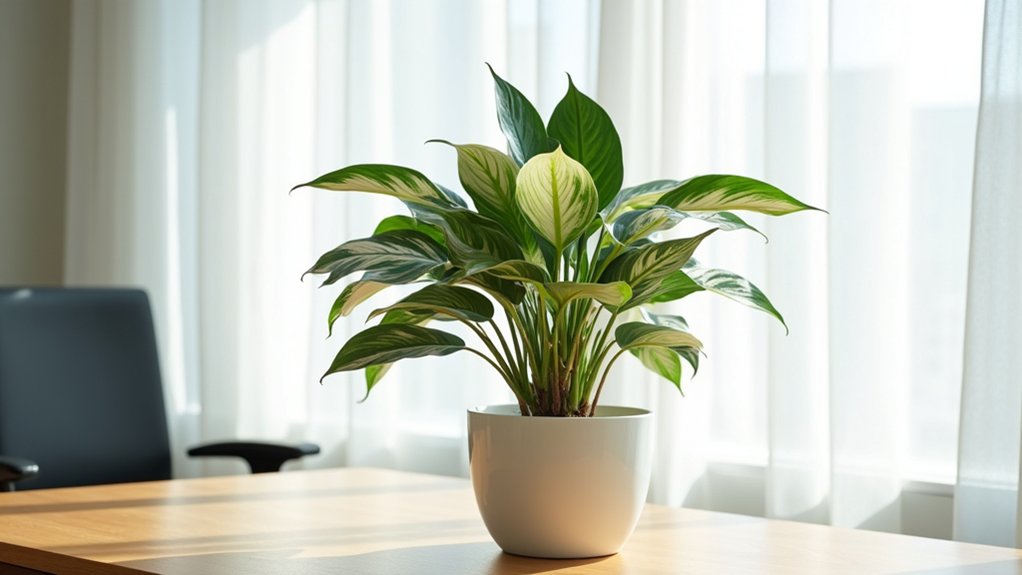
Chinese Evergreen (Aglaonema) is a striking tropical plant known for its exceptional adaptability and ornamental foliage. The plant features large, glossy leaves with distinctive patterns of silver, green, and cream variegation, growing in an attractive bushy formation that rarely exceeds three feet in height.
Its reputation as a “set-and-forget” option stems from its remarkable tolerance for less-than-ideal conditions and ability to thrive with minimal attention.
Growing Conditions:
- Light: Tolerates low to moderate indirect light; avoid direct sunlight
- Water: Allow top inch of soil to dry between waterings
- Temperature: 65-80°F (18-27°C)
- Humidity: Moderate to high; thrives in average indoor humidity
- Soil: Well-draining potting mix rich in organic matter
- Fertilizer: Light feeding with balanced fertilizer every 2-3 months during growing season
To maintain a healthy Chinese Evergreen, regularly dust the leaves with a damp cloth to keep them clean and photosynthesizing effectively.
Trim any yellowing or damaged leaves at the base to encourage new growth and maintain the plant’s attractive appearance.
Rotate the pot quarterly to ensure even growth, and watch for signs of pest infestation, particularly mealybugs and spider mites, which can be addressed with insecticidal soap if detected early.
Succulents: Compact Desktop Companions
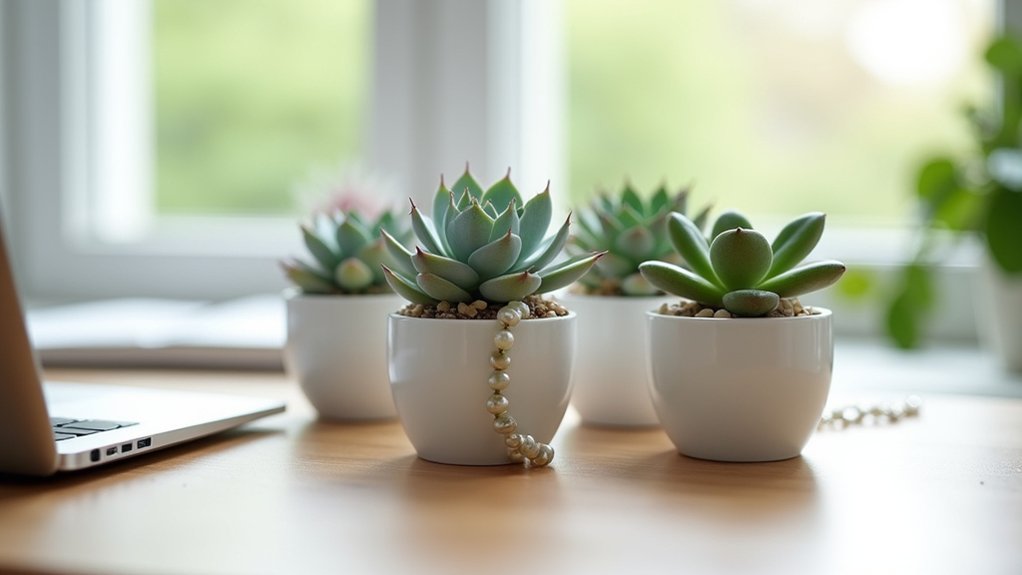
Succulents are the perfect miniature companions for office desks, featuring thick, fleshy leaves or stems that store water, giving them their distinctive plump appearance.
These compact plants come in a fascinating array of shapes, sizes, and colors, from rosette-forming echeverias to trailing string-of-pearls, making them visually interesting without taking up too much valuable desk space. Their modern, architectural forms complement any office aesthetic while requiring minimal attention to thrive.
Growing Conditions:
- Bright, indirect light; can tolerate some direct morning sun
- Well-draining cactus or succulent potting mix
- Water only when soil is completely dry (typically every 7-14 days)
- Room temperature between 65-80°F (18-27°C)
- Low humidity requirements
- Container must have drainage holes
To maintain healthy office succulents, rotate the pot quarter-turn weekly to ensure even growth, and remove any dead or yellowing leaves promptly to prevent potential pest issues.
Avoid fertilizing during winter months, but during the growing season (spring and summer), apply a diluted cactus fertilizer every 6-8 weeks.
Keep leaves dust-free by gently brushing with a small, soft paintbrush, and watch for signs of stretching or pale growth, which indicate insufficient light.
